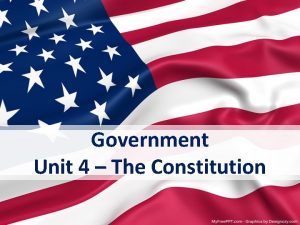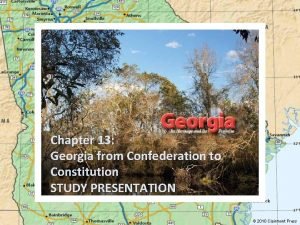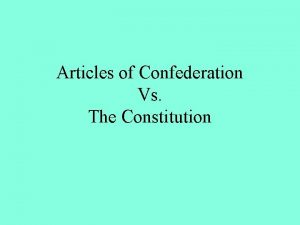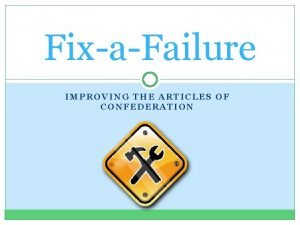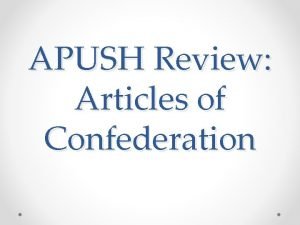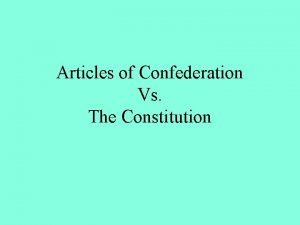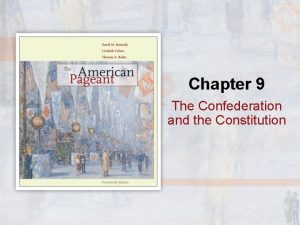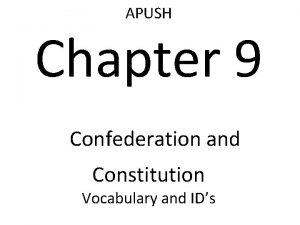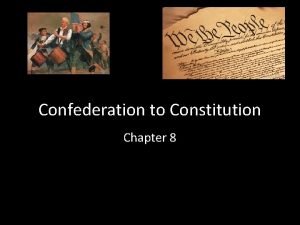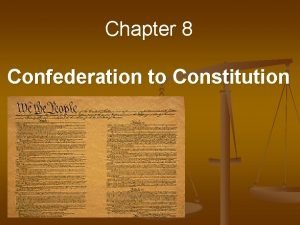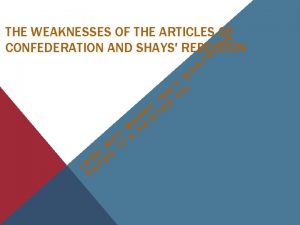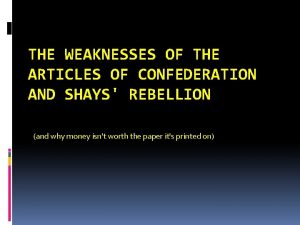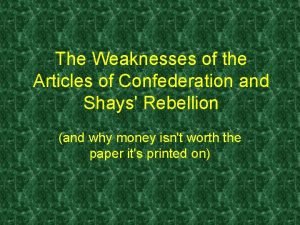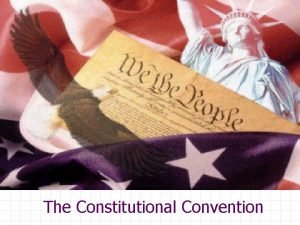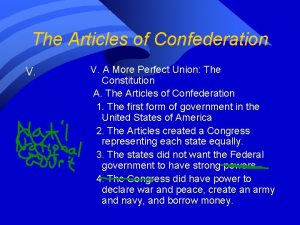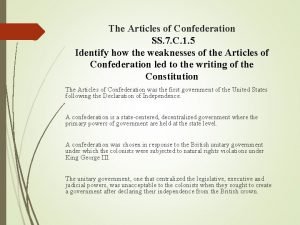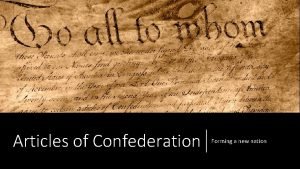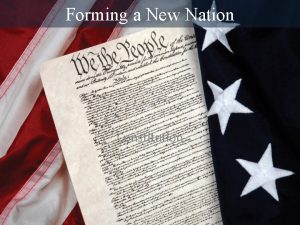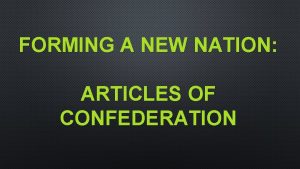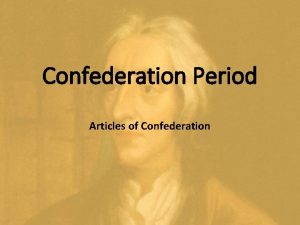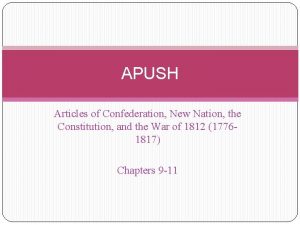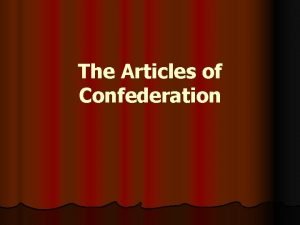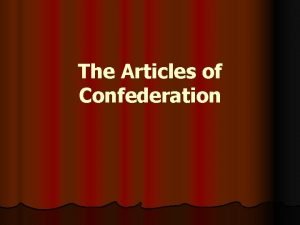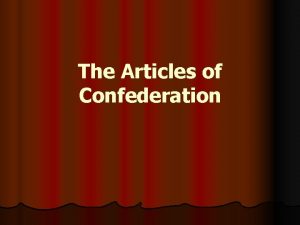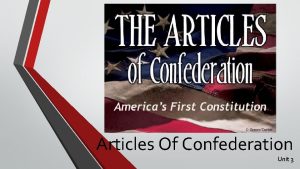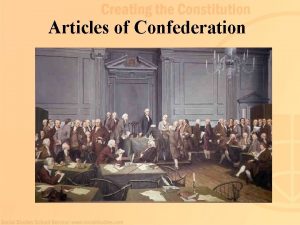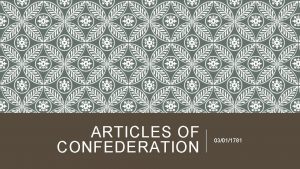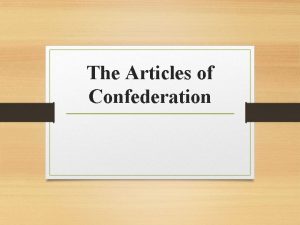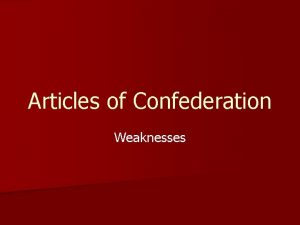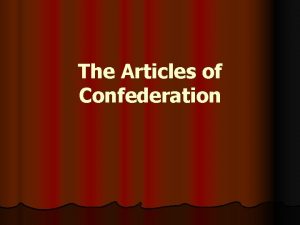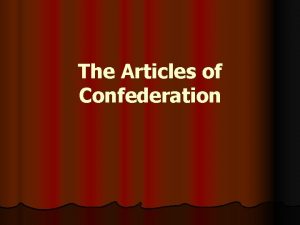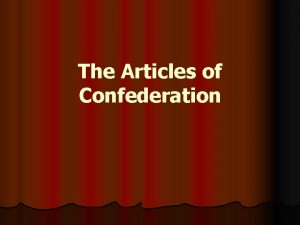Forming a New Nation Constitution Confederation Articles of

















- Slides: 17

Forming a New Nation Constitution

Confederation • Articles of Confederation – Original Constitution for a collection of States – John Dickenson (Penn. ) – Congress and delegates (up to 7 per state) – Single vote per state – No President, No Executive branch – Power spread amongst several committees

Powers of National Congress • Powers: – Declare war – Trade – Indian relations – No power to raise money, taxes merely ask for contributions – 2/3 of states had to approve of the above – Unanimous for amending the Articles

Northwest Territory • Describes the newly acquired land from the Ohio valley region • Land Ordinance of 1785 – Grid system of dividing up land – One square mile, township, 36 sections at least $1 per. • North West Ordinance of 1787 – Congress appoint territorial governor – 5, 000 men elect assembly – 60, 000 men, elect governor and create constitution – Barred slavery – All would come in as “free states”

Public Education Movement • Northern states rapidly established public schools. By the year 1870 • All states had tax-subsidized elementary schools. • The US population had one of the highest literacy rates in the world at the time. – Private academies also flourished in the towns across the country, but rural areas had few schools before the 1880 s. • In 1821, Boston started the first public high school in the United States. – By the close of the 19 th century, public secondary schools began to outnumber private ones.

Shays’ Rebellion • Testing the Articles of Confederation • Farmers of Mass. And Penn. Facing large debt • Led by Daniel Shays • Mass. Raised an army to put down the rebellion • Pres. Washington gets involved, the rebellion is suppressed • Showed that the Articles could not enforce people to pay taxes.

Weaknesses of Articles exposed • Shay’s Rebellion exposed: – No central govt. to enforce laws – No way to collect taxes – Too difficult to manage for acceptance or change. – Shay was right! • Call for stronger central government – Due to the lack of ability to enforce laws, or to collect taxes for governmental income. – Support to all states – Something to bring states together for the good of all

Drafting the Constitution • James Madison forms a committee to create a constitution to present to the Constitutional Congress that includes Alexander Hamilton – Hamilton not in favor of Democracy, Madison favored Republicanism • During session George Washington is unanimously elected president. Battle over representation begins.

Virginia Plan • Favors larger states • Representation should be based upon: – Donation / wealth – Population – Bicameral legislature

New Jersey Plan • Favors smaller states • Calls for representation by: – Statehood: same number per state – unicameral

Connecticut Plan • Also known as the Great Compromise – Stated: • Bicameral • One house will be the House of Representatives, based upon population • One house will be the Senate, based upon statehood, 2 per state

3/5 Compromise • Southern states fearing Northern dominance want to include their slaves into the population count. • Northern states argued that slaves were not citizens. • Congress decided to count 3 out of every 5 slaves to appease the Southern States.

Limited government • James Madison – Believe that the people should have a say in government – The citizens should be able to decide the path of government through representation • A Republic • Alexander Hamilton – Believed there should be a “ruling class”. – Ordinary citizens do not posses the knowledge needed to run a government or country.

Ratification • Federalist – Favored a strong central government – Sought to plug holes of the articles – Washington, Madison, Hamilton • Antifederalist – Favored stronger state and local governments – Lack of bill of rights – Protect people from oppressive government – Richard Henry Lee, Patrick Henry, John Hancock, Samuel Adams

Federalist Papers • James Madison, John Jay, and Alexander Hamilton • Series of papers set out to explain in “plain” terms what the constitution is and provides. • Explains checks and balances • Efforts to get the constitution ratified

Bill of Rights • Pushed by Antifederalists like Jefferson • Claimed that citizens need to see and know their natural rights • Provide documented rights such as: – Speech, assembly, religion, bear arms, press, trial by jury, etc.

Making it official • Delaware, Penn, NJ, Georgia, Connecticut sign on 1 st. • Massachusetts comes in next • Slowly Maryland, SC, and NH • Virginia and New York are near the end, larger states, must haves • After the Bill of Rights are amended into the constitution all states ratify the constitution.
 Articles of confederation vs constitution
Articles of confederation vs constitution Articles of confederation vs constitution
Articles of confederation vs constitution Constitution vs articles of confederation
Constitution vs articles of confederation Issues with the articles of confederation
Issues with the articles of confederation Articles of confederation vs constitution apush
Articles of confederation vs constitution apush Articles of confederation vs constitution chart
Articles of confederation vs constitution chart Chapter 9 the confederation and the constitution
Chapter 9 the confederation and the constitution Chapter 9 confederation and constitution
Chapter 9 confederation and constitution Chapter 8 confederation to constitution
Chapter 8 confederation to constitution Chapter 8 confederation to constitution
Chapter 8 confederation to constitution Political weaknesses of the articles of confederation
Political weaknesses of the articles of confederation Achievements of the articles of confederation
Achievements of the articles of confederation Problems with articles of confederation
Problems with articles of confederation Articles of confederation strengths
Articles of confederation strengths When was the great compromise
When was the great compromise Strengths of the articles of confederation
Strengths of the articles of confederation Articles of confederation weaknesses
Articles of confederation weaknesses 3 weaknesses of the articles of confederation
3 weaknesses of the articles of confederation
